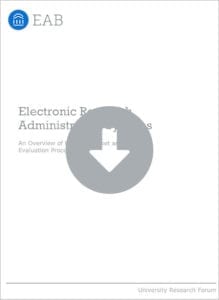
Most research sponsors, including the federal government, have moved from paper application and award management processes to online systems. In response, university administrators have implemented Electronic Research Administration (ERA) systems to increase efficiency, security, and ease-of-use, as well as to align university processes with those of research sponsors.
This white paper explores how chief research officers can better navigate the evolving ERA landscape.
This whitepaper was first published in 2016 and re-published in 2018. This updated resource offers additional information on compliance modules and includes a new evaluation framework to help CROs and staff determine which functions and components to prioritize when implementing new ERA tools.
Chief research officers select systems on a continuum between ‘configuration’ and ‘customization’
Systems on the configuration end of the spectrum require less back-end customization and offer more support, but cannot be completely tailored to campus needs. Configuration-type systems require CROs to spend more on licensing costs, while customization-type systems require CROs to hire additional IT staff. Contacts report that most mature vendors offer the same core capabilities, and that most vendor vetting occurs on the desired level of customization rather than breadth of capability offerings. Learn more on p. 6
CROs seek to integrate whichever tools best match their institutions’ needs, rather than buy entire suites of services.
CROs select ERA functions based on performance, and connect the functions through system-to-system crosswalks, customized crosswalks, or through back-end data warehouses. Most universities do not implement all modules from a single vendor, and instead opt to select other systems for research-related functions, such as compliance and grant identification. Learn more on p. 9
Overall satisfaction with profiled vendors is tepid, and contacts report no single vendor provides a sufficient full life-cycle product.
Since the decentralization of the federal system for accepting grant applications on Grants.gov made many previous ERA decisions less advantageous, CROs and their teams continuously monitor the ERA market for potentially better services. Some institutions have developed portals or dashboards to make current systems more user-friendly or have integrated ERA systems with updated homegrown tools. Learn more on p. 10
